Soda Dungeon Review: Brilliant but lazy

In the bustling world of indie games, where the quest for innovation often leads to both triumphs and missteps, Soda Dungeon emerges as a quirky contender. Combining nostalgic pixel art with a unique blend of dungeon crawling and auto-battling mechanics, this game offers a refreshingly whimsical take on the genre. Set within a tavern where magical sodas bring forth a motley crew of heroes, Soda Dungeon invites players to embark on a dimension-hopping journey fraught with repetitive floors and a minimalist story. While the game's charm lies in its vibrant art and engaging customization, it also stumbles in areas like combat depth and dungeon variety. For those who relish the simplicity of auto-battling and the satisfaction of optimal team building, Soda Dungeon might be the perfect casual diversion. However, for players seeking a more robust and intricate experience, it may fall short of expectations. Now, without further ado, I, Brighton Nelson of RPG Ranked present to you today's article: a Soda Dungeon Review: Brilliant but lazy.
Combat - 6.5

Soda Dungeon has an interesting combat style. Every character recruit is pretty barebones—the objective is less about choosing the right moves in combat and more about choosing the right recruits for combat. I'll run through notable recruits now. There's the Fighter, who focuses on dishing out double damage with his Dropkick ability. There's the Conjurer, a low-level mage with useful item abilities that bring immense support to the team in the early game. There's the Healer, a valuable unit that stands as the only support mage in the game, with both single-target and group healing abilities. There's the Thief, a unit that can steal, open additional treasure chests, and focus on racking up damage that is boosted by critical hit percentages via armor, equipment, or items. There's the Knight, a unit not quite as strong as the Fighter but much more helpful, as he has a multi-target damage ability, the ability to guard critically injured allies, and avoid harmful traps that will put your allies in danger. There's the Merchant, a weak unit with no physical or magic abilities but an absolute boss-killer with his ability to use Gold to cut enemy HP in half. There's the Darkmage, a complete upgrade to the Conjurer and one of the game's most vital units, as she dishes out absurd magical damage and inflicts debilitating status ailments that shift the tide and tempo of battle. There's the Ragezerker, who goes berserk in dishing out damage and permanently buffing the attacks of allies. There are also a few really unique special units, but I'll let you discover those yourself. There are also a few really unique special units, but I'll let you discover those for yourself. Once you build your team in the way that you'd like, that's where the combat in this game starts.
You enter the dungeon, and your team of five will head to battle! Here's the catch: the setup and preparation for battle are the real fun here. Once you start actually battling, though, it isn't very impressive. So, what is the optimal way to play with how the game works? Auto-battling. With so few abilities upon entering battle, it's more fun that way anyway, and watching your people demolish everything in their path in record time is very satisfying. And once you get the Magic Clock upgrade, auto-battling goes remarkably fast. Like so, so, so fast. The most fun aspect is constantly failing and finding new ways to outfit your team optimally! Ultimately, while this game is not the best in terms of combat (and especially not in terms of conventional combat), it has a unique charm to it. Nevertheless, when a game's setup is fun, but the actual combat is subpar, I can't give this game a high score.
Dungeons - 4
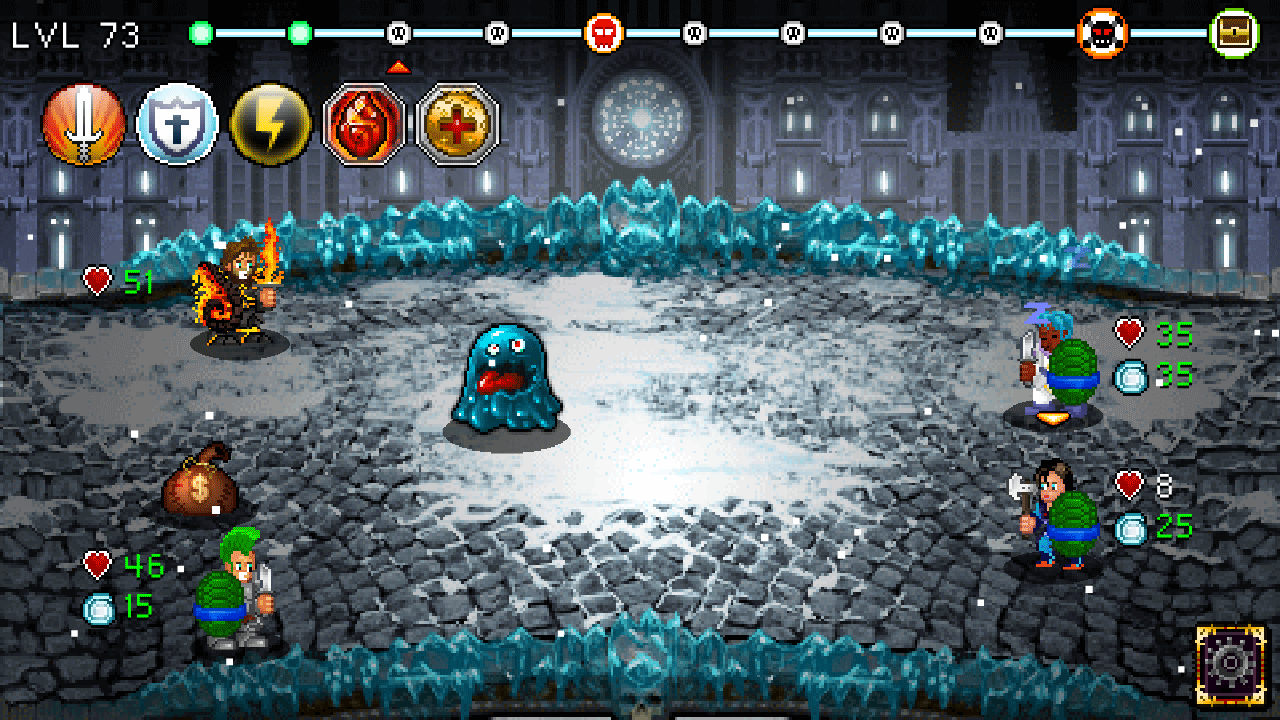
In a dungeon crawler, having a good dungeon is imperative. It's not that Soda Dungeon has a bad dungeon, but, unfortunately, every hundred floors repeat themselves, but with higher statistics. The floors are good, but not great. How it works is that, until the thousandth floor, each one-hundredth floor has a dungeon boss to defeat and, to progress, you must enter a new dimension after every hundredth, restarting you with new gear and new heroes (but, luckily, tavern upgrades stay intact). While I found myself really enjoying the aspect of going to new dimensions, the main dungeon is really lacking. There's also the Lair of Despair dungeon, which, unfortunately, has the same issues. Every 100 floors repeat themselves, and while they offer new bosses, they still struggle to be anything special. So, in the end, with only 200 unique floors (with no exploration, might I add), this game is lacking, even though it brings cool ideas to the table.
Customization System - 8.5
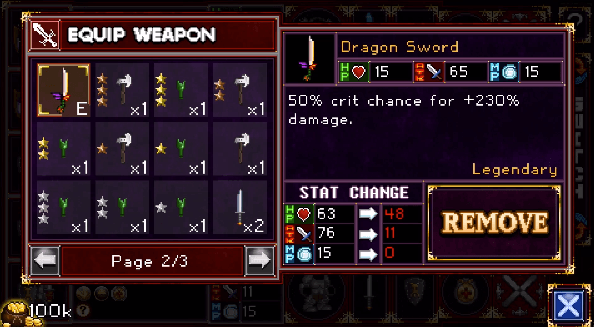
As aforementioned, you can customize your party makeup any way you would like! That includes the units I mentioned, as well as the awful ones that weren't worth discussing or the super cool ones I didn't want to spoil. However, there are way more options than just customizing your characters! To unlock these characters, you have to buy fancy, magical sodas at your tavern, which is nice! And these sodas don't carry over between dimensions, so you get the satisfaction of unlocking powerful characters ten times (or the dissatisfaction of constant annoyance... I sit somewhere in between the two arguments).

Other than character-unlocking sodas, there are four different types of upgrades: tavern upgrades, VIP upgrades, equipment, and relics. Tavern upgrades and VIP upgrades are costly but carry over dimensions, equipment doesn't carry over dimensions, and relics progressively get more substantial and more relevant the further you progress in the game.
Tavern upgrades include things such as a kitchen, which upgrades the health of your recruits; the beds, which allow you to refresh recruits if you have too many bad recruits on screen; decor because, well, decoration is nice; casks, which (for some reason) give you discounts on hiring recruits; stools and tables, which give you more variety to which characters you have to recruit; and, easily, the best of all, the Wizard, who allows you to teleport to the floor which you died last and progress from there.
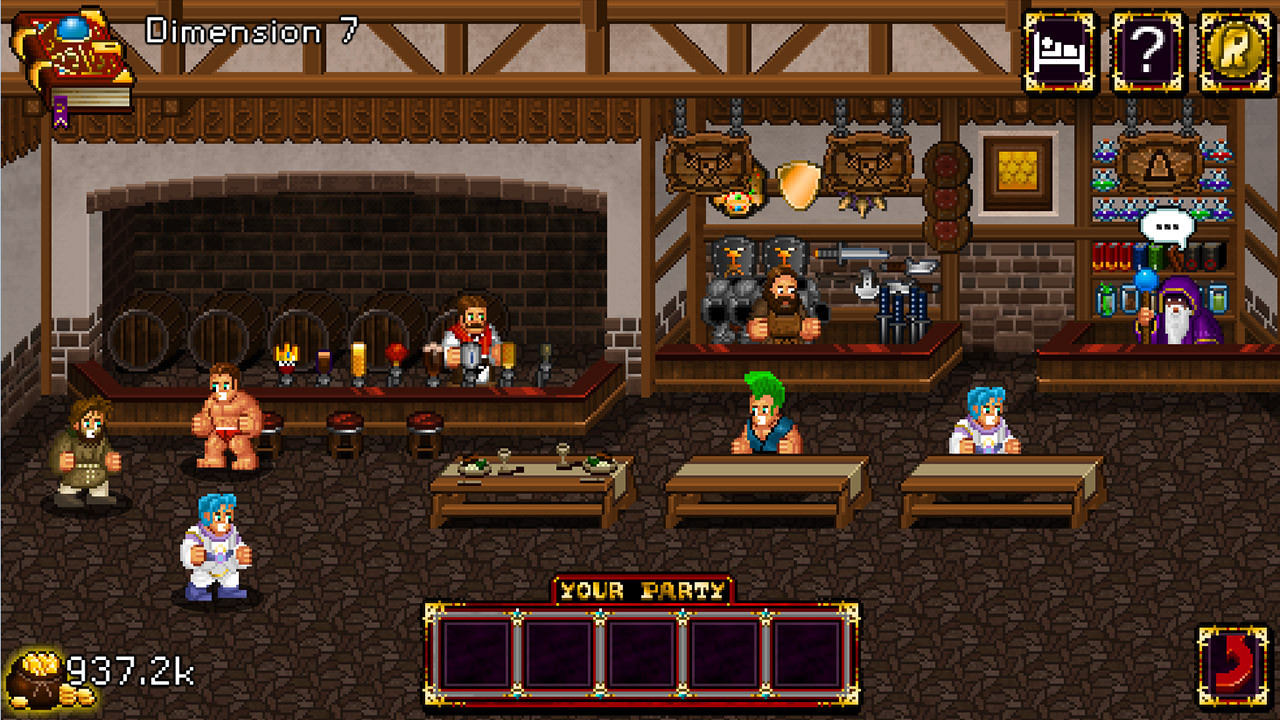
Now for the VIP upgrades, which are significantly more intriguing. There's the ability to buy an upgrade that gives each class a customizable, preset loadout that saves time in the equipping phase, which is a lovely quality-of-life feature (albeit something that should've been available from the get-go); the Inherit feature, which allows you to bring some much-needed Gold along as you cross dimensions; the Warp upgrade, which will enable you to instantly skip hundreds of floors to speed up the game if you'd like; gnomes, which give you multipliers on Essence you gain after dungeon runs (Essence is a second currency I will cover in a moment); the Magic Well, which can convert Gold into Essence, which is incredibly useful; customization options to change hero appearances; All-Sight and Magic Clock, which show enemy HP and speed up auto-battle animations, respectively; and my personal favorite, the Pet Stables.
The Pet Stables allow you to assign a pet as a sixth party member, which grants an innate boost to your party! Robbie increases item drops, Ray increases your max MP, Ernie increases your max HP, Jenny increases gold drops (my personal favorite, of course), Crespia increases your attack stat, Norm buffs your attacks by a percentage (much better than Crespia), Charlie provides a percentage magic attack boost, Dasha gives MP regeneration, Tufts gives HP regeneration, and Steamy delivers a bonus critical hit chance with magic spells. And, of course, all these pets level up the more you use them, so pick your favorite and make them as strong as you can! To briefly cover equipment, there are four types: armor, shields, weapons, and accessories. However, what sets apart equipment in this game is that there are actually reasons to equip earlier equipment over later equipment, which is an excellent quality that always spices up games for me.

Last but not least is the most fun customization option of all: Relics. Each time you enter a new dimension, you get a new Relic. Prior to gaining your first Relic, there is no way to level up your characters. Of course, you are still becoming stronger as you purchase new sodas and get more units. Still, as you progress to later dimensions, that isn't anywhere near enough, as even the expensive units start to get trounced. Basically, relics are how you level up in this game. And, of course, they are displayed as fancy sodas in glass bottles, as opposed to sodas off the tap, because, of course, it is Soda Dungeon. Most relics can be upgraded as many times as you like by using Essence, which allows your team to get extraordinarily strong. Since I've already rambled so long, I may as well continue. Constitution Cola buffs health, Vigor Swig buffs the attack stat, Cauldron Bubble buffs MP, True-Strike Soda buffs critical hit chance (only up to 25%), Liquid Gold buffs how much Gold you earn, Potable Potion buffs magic damage by a percentage, Damage Quench buffs the amount of damage critical hits deal (up to 50%), Evader-Aid buffs your characters' evasion rate (up to 15%), Effervescence increases essence drop rates (up to 100%), Sip of Vitality proves HP regeneration every turn (up to 100), and the ultimate super expensive Relic, Combat Crush, which boosts physical attack damage by a percentage. Also, each hero has a Relic Badge separate from the Relic Sodas, allowing you to upgrade your favorite heroes as you would like. Ultimately, this game doesn't quite have as intricate customization as some games (I made it sound more complex and unique than it is in practice), but it is still really unique, and I love it!
Art & Graphics - 9
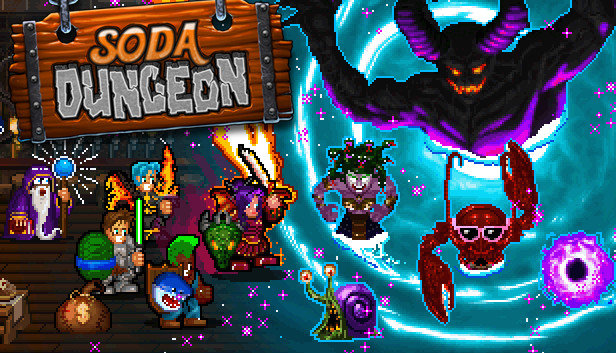
Soda Dungeon hearkens back to a time of nostalgic pixel art in which everything was a little more straightforward. Okay, not to sound like an old man, but the way this game does its art exuberates retro charm. It doesn't try to hide the pixels nearly as much as newer indie pixel art such as Chained Echoes or Sea of Stars. As much as I adore crisp, clean indie pixel art, I also love how much Soda Dungeon leans into the pixelated simplicity of things. And if one of you Gen Z gamers stumble upon this article and starts mocking me, I'll have you know I am also part of that generation, and there's about a 50% chance I'm younger than you—don't you dare diss the pixel art of a simpler, less tumultuous time. But I digress. TL;DR: This game is beautiful, so let's move on.
Theming - 8

I love the prospect of getting a motley crew together through the power of magical soda in a tavern and inter-dimensionally traveling to different dimensions until you kill every dungeon boss and bring peace to the multiverse or whatnot. In the end, while more unique ideas certainly exist, it doesn't need to be complex to make me like its theming.
Story - 0

The story in this game boils down to warping across eleven dimensions and killing dungeon bosses to save the world. It isn't the worst story I've seen in a game, but it is close and is about as barebones as necessary to fuel the gameplay. As always, that is immensely saddening and disheartening.
Music - 8
Soda Dungeon is really not the type of game I'd expect to have absolutely banging music, but, well, it does. When I'm driving or working on homework or whatever I happen to be doing while idle-grinding Soda Dungeon, and I hear that music, I'm instantly groovin'. While the soundtrack is concise and not too extensive, its quality and variety deserve a high score! However, with soundtracks like Final Fantasy XV and Lost Odyssey existing out there, I can't give this category a ten.
Sidequests - 2
This game has the main dungeon, the Lair of Despair, and the Coliseum. The second is basically a reskinned version of the first and the Coliseum has so few levels its reward become practically obsolete after a dimension or two. Sure, if your Relics are at obscenely high levels and require immense amounts of Essence, it might be worth your time to challenge the overly-easy final level of the Coliseum for some otherwise premium Relic Tokens, but otherwise? The side-content is pretty lacking in this game.
Quality of Life - 9

While I can totally get behind people disliking losing class unlocks, Gold, and equipment, I don't really mind that. My only real issue is that some of the quality-of-life issues are locked behind upgrades for no good reason, and some of the auto-battle AI does not work well at all. The Healer never uses its group heal when controlled by AI, the Thief never steals, and the Knight uses its situational AoE attack far too often (and once it gets its upgraded AoE attack, it uses that one way less than it should). Regardless, that doesn't even nearly put me off from this game since the AI can still find ways to win battles anyway, so it isn't a big deal.
The Verdict

Fun Factor: 8
Overall Score: 63%
Letter Rating: B
Soda Dungeon is the textbook definition of the perfect game to play when you are busy or when doing something else. The game has fun customization, art, and music that will always hook me in immediately. However, even with great merits, this game is full of flaws every step of the way, so, unfortunately, I'd only recommend this game to people who love auto-battling or are fine multitasking while playing the game. It does so much right, yet, unfortunately, it also does a few things wrong.
Primary Version: Soda Dungeon (PC)